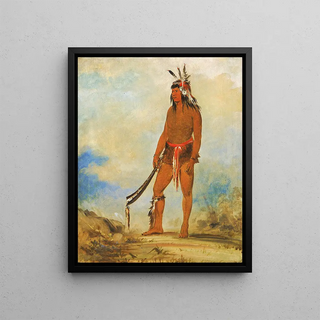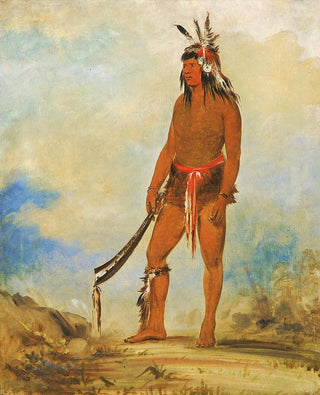Art print | WonderTWA La Merveille - George Catlin


View from behind

Frame (optional)
In the fascinating universe of art, some works transcend the simple frame to become windows into vanished worlds. "WonDeTwA La Merveille - George Catlin" fits into this tradition, offering an immersion into the soul of Indigenous peoples of America. This piece does not merely depict a scene; it awakens an insatiable curiosity for the cultures and traditions that shaped this continent. Through Catlin's brushstrokes, the viewer is transported on a temporal journey, where every detail reveals a profound and emotive story. This art print, while preserving the essence of the original, invites rediscovery of the wonders of a often little-known world.
Style and uniqueness of the work
George Catlin's style is distinguished by his ability to capture the spirit of the subjects he portrays. In "WonDeTwA La Merveille," each color, each stroke is carefully chosen to evoke not only the physical appearance of the characters but also their character and culture. Catlin excels in the use of light and shadow, creating striking contrasts that bring his subjects to life. The piece is characterized by meticulous precision, combined with an artistic sensitivity that pays homage to the richness of Native American traditions. The expressions on faces, the postures of bodies, all seem to vibrate with palpable energy, attesting to attentive and respectful observation. This singularity makes "WonDeTwA La Merveille" an essential piece for anyone interested in art and history.
The artist and his influence
George Catlin, 19th-century artist and ethnographer, dedicated his life to documenting Native American cultures through his paintings. His work is the result of an authentic passion and a deep commitment to preserving traditions threatened by colonial expansion. At a time when the voices of Indigenous peoples were often ignored, Catlin was able to give visibility to these cultures through his art. His influence extends well beyond his era, inspiring many artists and researchers to explore themes of identity and cultural memory. In revisiting "Won

Matte finish

View from behind

Frame (optional)
In the fascinating universe of art, some works transcend the simple frame to become windows into vanished worlds. "WonDeTwA La Merveille - George Catlin" fits into this tradition, offering an immersion into the soul of Indigenous peoples of America. This piece does not merely depict a scene; it awakens an insatiable curiosity for the cultures and traditions that shaped this continent. Through Catlin's brushstrokes, the viewer is transported on a temporal journey, where every detail reveals a profound and emotive story. This art print, while preserving the essence of the original, invites rediscovery of the wonders of a often little-known world.
Style and uniqueness of the work
George Catlin's style is distinguished by his ability to capture the spirit of the subjects he portrays. In "WonDeTwA La Merveille," each color, each stroke is carefully chosen to evoke not only the physical appearance of the characters but also their character and culture. Catlin excels in the use of light and shadow, creating striking contrasts that bring his subjects to life. The piece is characterized by meticulous precision, combined with an artistic sensitivity that pays homage to the richness of Native American traditions. The expressions on faces, the postures of bodies, all seem to vibrate with palpable energy, attesting to attentive and respectful observation. This singularity makes "WonDeTwA La Merveille" an essential piece for anyone interested in art and history.
The artist and his influence
George Catlin, 19th-century artist and ethnographer, dedicated his life to documenting Native American cultures through his paintings. His work is the result of an authentic passion and a deep commitment to preserving traditions threatened by colonial expansion. At a time when the voices of Indigenous peoples were often ignored, Catlin was able to give visibility to these cultures through his art. His influence extends well beyond his era, inspiring many artists and researchers to explore themes of identity and cultural memory. In revisiting "Won






